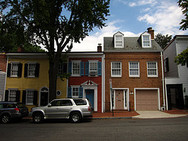Will Georgetown’s campus plan collapse the area’s rental market?
In 2012, the Zoning Commission approved Georgetown’s latest campus plan. A central part of the plan is that the school committed to providing 385 new on-campus beds by the fall of 2015, with the long term goal of housing 90% of its undergrads on campus by 2025. With that first deadline rapidly approaching, is the rental market already feeling the pinch of reduced demand? A lot of residents I’ve talked to have concluded as much, and some anecdata supports that.
Recently, people have noticed homes still available for rent that would usually be already rented for the fall. And one particularly prominent house that has been rented for years (and is awfully shabby for it) is not only vacant but now for sale. It’s the home at 3348 Prospect. This large home can be yours for $3 million.
One argument I’ve made to those trying to force Georgetown to house more students on campus is that the rental housing would simply be filled by non-students, primarily 20-somethings, who can be just as loud and annoying as college students (I certainly was). But the Prospect Street house may point to a flaw in that argument. According to the listing, the house rents out nine “units” for a total rent of $18,000 a month. That wasn’t a typo.
It’s unclear how many bedrooms the house has (the listing could be read to mean nine, but also up to twelve), but it’s very unlikely that anyone other than a Georgetown student would be willing to pay that much to share that building with so many people. And with so many new condos all over the city much closer to more popular neighborhoods, maybe there really aren’t that many 20-somethings that want to move to Georgetown period, let alone at the usurious rates that undergrads pay.
And it seems that a collapse in demand is about the only thing that would explain why someone would want to sell a property producing $155,000 a year net profit. The listing claims the $3 million price was arrived at to achieve a 5% capitalization rate. This would be a decent cap rate, but only if it’s actually true. And maybe the fact the owner is selling suggests that he or she doesn’t think it is.
A version of this post originally ran on The Georgetown Metropolitan.


